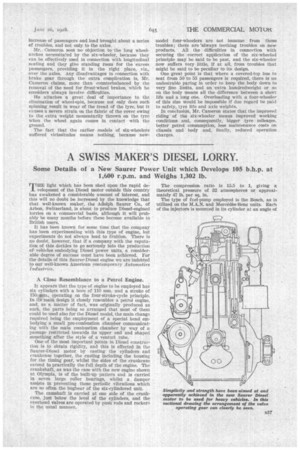A SWISS MAKER'S DIESEL LORRY.
Page 63

Page 64

If you've noticed an error in this article please click here to report it so we can fix it.
Some Details of a New Saurer Power Unit which Develops 105 b.h.p. at 1,600 r.p.m. and Weighs 1,302 lb.
rilEIE light which has been shell upon the rapid de velopment of the Diesel motor outside this country has awakened a considerable amount of interest, and this will no doubt be increased by the knowledge that that well-known maker, the Adolph Saurer Co., of Arbon, Switzerland, is about to produce Diesel-enginetl lorries on a commercial basis, although it will probably be many months before these become available to British users.
It has been known for some time that the company has been experimenting with this type of engine, but experiments do not always lead to fruition. There is no doubt, however, that if a company with the reputation of this decides to go seriously into the production ofvehicles embodying Diesel power units, a considerable degree of success must have been achieved. For the details of this Saurer-Diesel engine we are indebted to our well-known American contemporary Automotive industries.
A Close Resemblance to a Petrol Engine.
It appears that the type of engine to be employed has six cylinders with a bore of 110 mm. and a stroke of 150 natn., operating on the four-stroke-cycle principle. In its main design it closely resembles a. petrol engine, and, as a matter of fact, was originally produced as such, the parts being so arranged that most of them could be used also for the Diesel model, the main change required being the employment of a special head embodying a small pre-combustion chamber communicating with the main combustion chamber by way of a passage restricted towards its upper end and shaped something after the style of a•venturi tube.
One of the most. important points in Diesel construction is to obtain rigidity, and this is effected in the Saurer-Diesel motor by casting the cylinders and crankcase together, the casting including the housing for the timing gear, whilst the sides of the crankcase extend to practically the toll depth of the engine. The crankshaft, as was the case with the new engine shown at Olympia, is of the built-up pattern and is carried in seven large roller bearings, whilst a damper assists in preventing those periodic vibrations which are so often the bugbear of the six-cylindered unit.
The camshaft is carried at one side of the crankcase, just below the level of the cylinders, and the overhead valves are operated by push rods and rockers in the usual manner.
The compression ratio is 15.5 to 1, giving a theoretical pressure of 32 atmospheres or approximately 47 lb. per sq. in.
The type of fuel-pump employed is the Bosch, as is utilized on the M.A.N. and Merc&le.s-Benz units. Each of the injector S is mounted in its cylinder at an angle of
approximately 30 degrees so that the spray is directed upwards through the venturi orifice and inte the precombustion chamber. It will be neted from tile drawing which we reproduce that the flow of fuel into this chamber is assisted by the air which is also being compressed into it. To assist the ignition of the fuel, the pre-combustion chamber (which, incidentally, is of steel) has no water jacket and it is so mounted that its extra expansion dile to this fact is allowed for. A single aluminium cover plate protects these heated chambers. The pressure of injection is approximately 60 atmospheres, and it is stated that the injection always begins at the same point in relation to the position of the piston, but is cut off as is required according to the engine speed..
The weight of this unit is. comparable with that of the equivalent petrol motor, but the power developed is some 15 per cent. less. A governor restricts the speed to 1,200 r.p.m., but tests have been made up to 1,800 r.p.m.
Electrically Heated Starting Plugs, For starting purposes the engines are warmed by the use of hot water in the jackets, and electrically heated plugs are employed, as is the case with the -Mercedes-Benz unit, the crankshaft being rotated or a starter motor after the heating has been carried on for a few seconds. R la claimed that the consumption of gas oil on the Saurer Diesel is .52 lb. per b.h.p.-hour.
The total weight of the complete lorry is approximately 5 tons, and carrying a pay load of 31 tons it is stated to have averaged just over 9 miles to the gallon of gas oil, whilst the consumption was 13 miles to the gallon when running without load. In a similar truck equipped with a petrol motor of the same size the mileage per gallon of petrol was 6.7 loaded and only 7.7 unladen. A. striking point is the flexibility of the Diesel unit. A Saurer lorry with this form of engine can be started away with full load on the third of its four gears, can be throttled down to 4 m.p.h. and can be accelerated from 4.3 m.p.h. to 24.8 m.p.h. in 62 seconds.
The specific gravity of the gas oil employed is .86, and, as we noticed in the case of the Mercedes-Benz unit, there was practically no smell from the exhaust.




















































































































